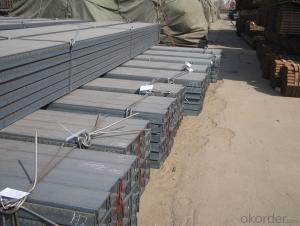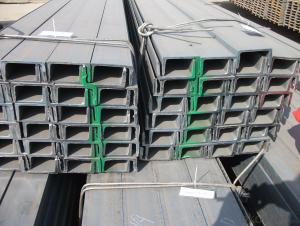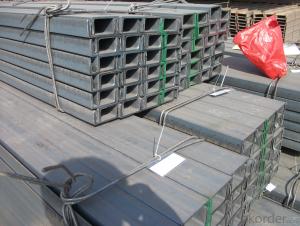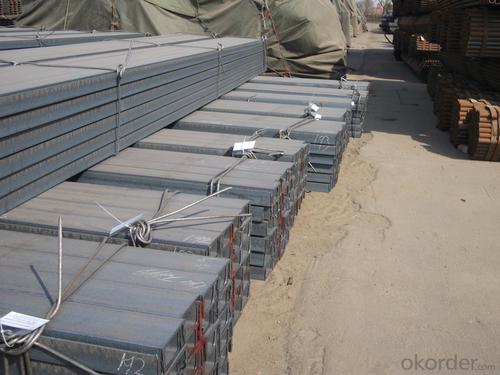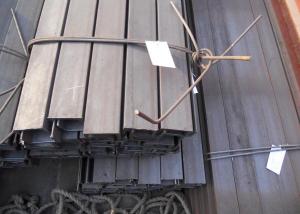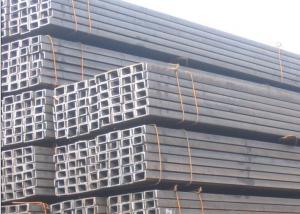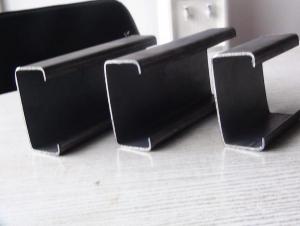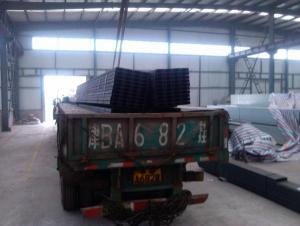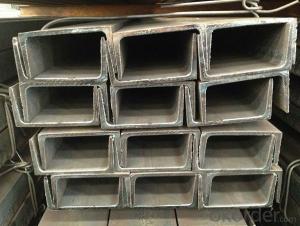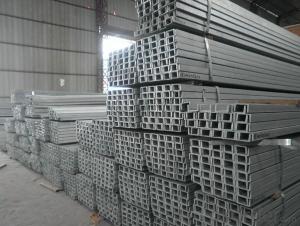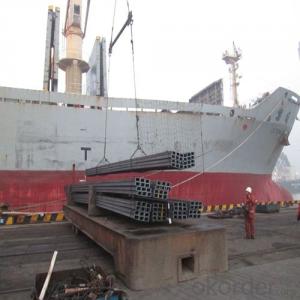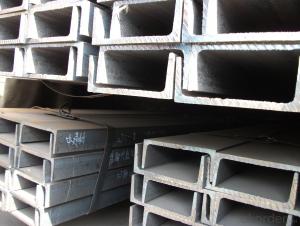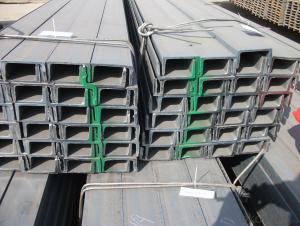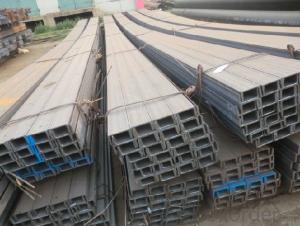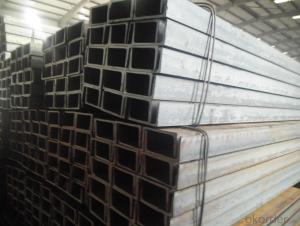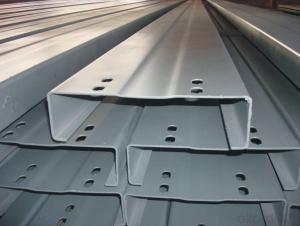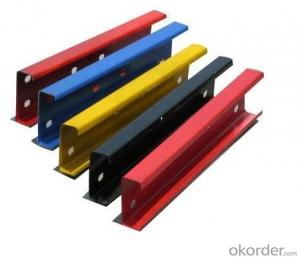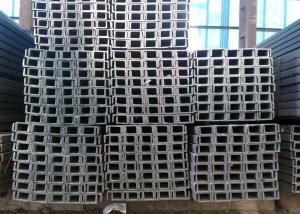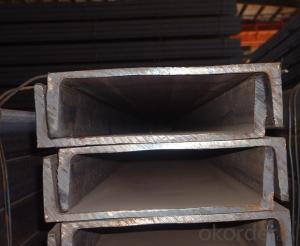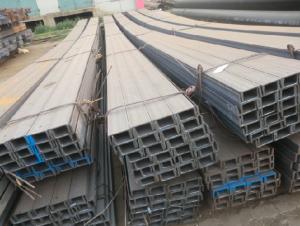JIS GB Standard Hot Rolled Steel U-channel
- Loading Port:
- China Main Port
- Payment Terms:
- TT or LC
- Min Order Qty:
- -
- Supply Capability:
- -
OKorder Service Pledge
OKorder Financial Service
You Might Also Like
Product Description:
OKorder is offering STEEL CHANNEL at great prices with worldwide shipping. Our supplier is a world-class manufacturer of steel, with our products utilized the world over. OKorder annually supplies products to European, North American and Asian markets. We provide quotations within 24 hours of receiving an inquiry and guarantee competitive prices.
Product Applications:
1.The JIS channel can be devided into two kinds, namely common channel steel and light channel steel. The sizes of hot rolled common channel steel range from 5# to 40#. Meanwhile, the channel steel can be divided into cold forming sectional equal channel steel, cold forming sectional unequal channel steel, cold forming inner edge channel steel and outer edge channel steel.
2.The JIS channel is usually used for arch-itechtural structure, and they could be welded in order to support or hang a vari-ety of facilities. They are also usually used in combination with I beam. The channel steel with sizes under 14# is usually applied to construction engineering, as purline, while the channel steel with sizes above 16# is more likely to be used in building vehicle chassis structure and mechanical structure. Furthermore, the channel steel in sizes above 30# are target at building bridge structure, as tension bar.
3.In a word, the channel steel must possess perfect welding property, riveting property and mechanical property and so on.
Product Advantages:
OKorder's STEEL CHANNELare durable, strong, and resist corrosion.
Main Product Features:
· Premium quality
· Prompt delivery & seaworthy packing (30 days after receiving deposit)
· Corrosion resistance
· Can be recycled and reused
· Mill test certification
· Professional Service
· Competitive pricing
Product Specifications:
Minimum Order Quantity: 25 Tons Unit: m.t. Loading Port: Xingang Port
Supply Ability: 1000 Tons Per Day Payment Terms: TT or L/C
Product Description:
Specifications of Steel U Channel:
Standard Applied: GB Standard, EN Standard(UPN), JIS Standard
Sizes: 50mm to 300mm
Material Grade: Q235B, Q345B, S235JR, SS400, ASTM A36
Production Flow of JIS Channel:
1.The steel billet shall be heated in the high temperature furnace.
2. The heated steel billet shall be rolled five to nine times with the aim of shaping the general figure of steel u channel.
3. The rolled steel channel should be put onto the cooling bed to make the temperature low.
4. The JIS Channel should be straighted on the straightener.
5. The straighted steel u channel will be cut into meters by saw, as per customer's requirements.
6. At the last part of production, the channel steel must be tested in order to confirm that the finished products are completely free from crack, pore, slag, scab or fold on the surface.
Package & Delivery of JIS Channel:
1.The JIS channel will be packed in bundle with steel wire at each end of every bundle and color marking in order to help the customer to recognize his goods more easily at sight.
2. And the JIS channel could be loaded into 20ft or 40ft container, or by bulk cargo.If the weight of each bundle reaches more than 3.5 mt, the loading by break bulk cargo should be choosed.When the weight of each bundle reaches less than 3mt, the loading by container should be choosed.
3.As for the transportaion from mill to loading port, the truck will be usually used. And the maximum quantity for each truck is 40mt.
4.All in all, we could do in accordance with customer's request.
JIS CHANNEL | Standard h | Sectional b | Dimension s | t | Mass: Kg/m |
| (mm) | (mm) | (mm) | (mm) |
|
50x25 | 50 | 25 | 3.0 | 6.00 | 2.37 |
75X40 | 75 | 40 | 3.8 | 7.00 | 5.30 |
75X40 | 75 | 40 | 4.0 | 7.00 | 5.60 |
75X40 | 75 | 40 | 4.5 | 7.00 | 5.85 |
75X40 | 75 | 40 | 5.0 | 7.00 | 6.92 |
|
|
|
|
|
|
100X50 | 100 | 50 | 3.8 | 6.00 | 7.30 |
100X50 | 100 | 50 | 4.2 | 6.00 | 8.03 |
100X50 | 100 | 50 | 4.5 | 7.50 | 8.97 |
100X50 | 100 | 50 | 5.0 | 7.50 | 9.36 |
|
|
|
|
|
|
125X65 | 125 | 65 | 5.2 | 6.80 | 11.66 |
125X65 | 125 | 65 | 5.3 | 6.80 | 12.17 |
125X65 | 125 | 65 | 5.5 | 8.00 | 12.91 |
125X65 | 125 | 65 | 6.0 | 8.00 | 13.40 |
|
|
|
|
|
|
150x75 | 150 | 75 | 5.5 | 7.30 | 14.66 |
150x75 | 150 | 75 | 5.7 | 10.00 | 16.71 |
150x75 | 150 | 75 | 6.0 | 10.00 | 17.90 |
150x75 | 150 | 75 | 6.5 | 10.00 | 18.60 |
150x75 | 150 | 75 | 6.5 | 10.00 | 24.00 |
|
|
|
|
|
|
200X80 | 200 | 80 | 7.5 | 11.00 | 24.60 |
Grade | Yield Strength,N/mm² | Extension Strength N/mm² | |||
Thickness of Steel,mm | |||||
≦16 | >16-≦40 | >40-≦100 | >100 | ||
SS330 | ≧205 | ≧195 | ≧175 | ≧165 | 330-430 |
SS400 | ≧245 | ≧235 | ≧215 | ≧205 | 400-510 |
SS490 | ≧285 | ≧275 | ≧255 | ≧245 | 490-610 |
SS540 | ≧400 | ≧390 | - | - | ≧540 |
Grade | Element(%) | |||
C | Mn | P | S | |
SS330 | -- | -- | ≦0.050 | ≦0.050 |
SS400 | ||||
SS490 | ||||
SS540 | ≦0.30 | ≦1.60 | ≦0.040 | ≦0.040 |
Images:
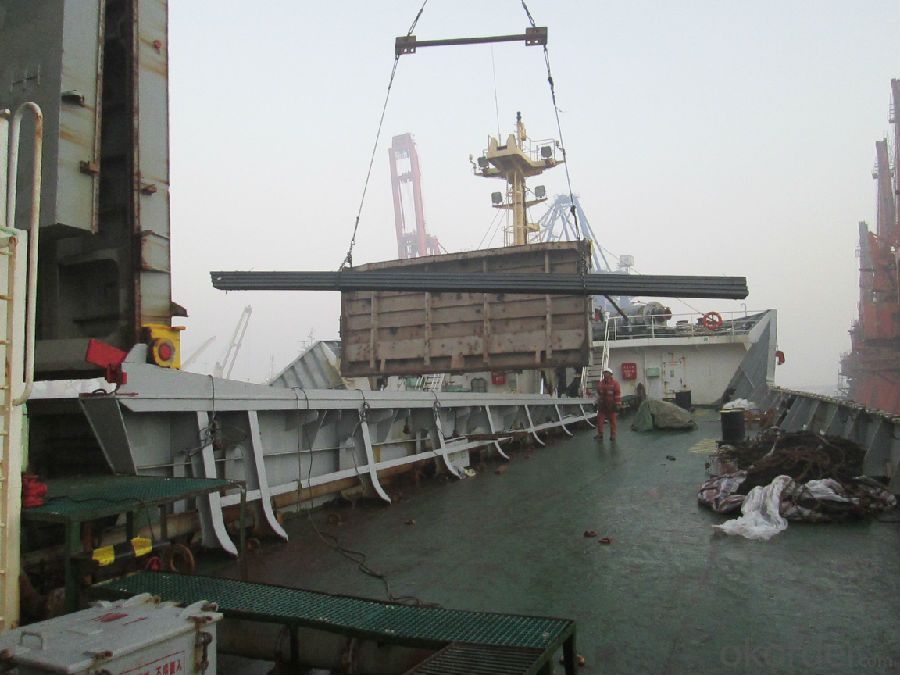
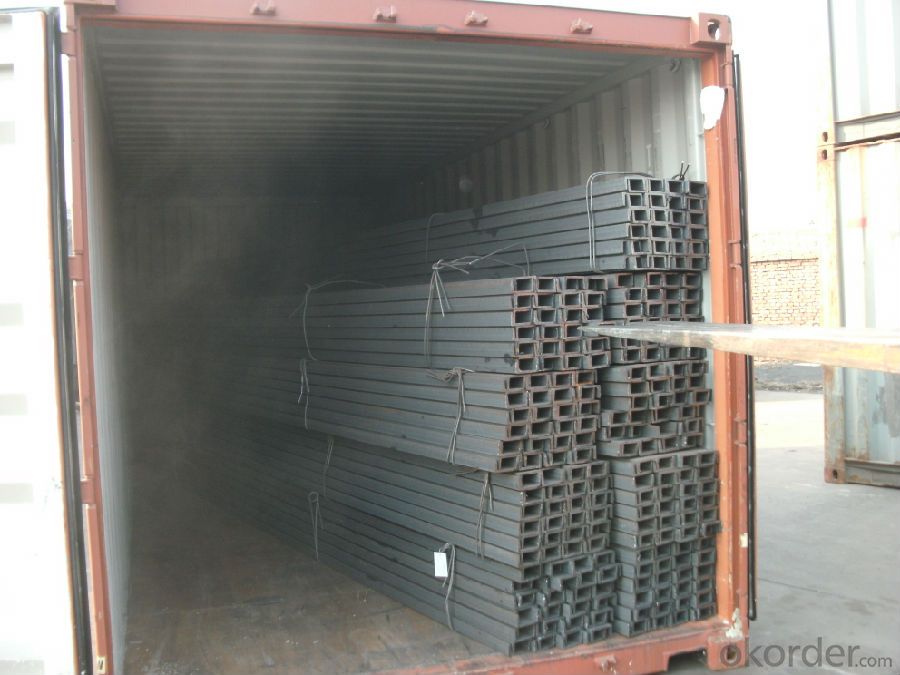
- Q: Can steel channels be used for mezzanine guardrails?
- Yes, steel channels can be used for mezzanine guardrails. Steel channels are often used in construction and industrial applications due to their strength and durability. They can provide a sturdy and secure barrier for mezzanine guardrails, ensuring the safety of workers and preventing falls from elevated platforms. Steel channels can be easily customized and installed to meet specific design requirements, making them a popular choice for mezzanine guardrail systems.
- Q: Do steel channels have any specific safety considerations?
- Yes, steel channels do have specific safety considerations. Steel channels are commonly used in construction and industrial applications for providing structural support, but they can pose certain safety risks if not handled properly. One safety consideration is the weight and size of steel channels. Steel channels can be heavy and difficult to maneuver, so proper lifting techniques should be used to prevent strain or injury to workers. Additionally, workers should be cautious when working under or around steel channels to avoid any potential accidents if they were to fall or collapse. Another safety consideration is the sharp edges and corners of steel channels. These sharp surfaces can cause cuts or punctures if proper precautions are not taken. Workers should wear appropriate protective gear such as gloves, safety glasses, and steel-toed boots to minimize the risk of injury. Fire safety is also a concern when working with steel channels. Steel is a good conductor of heat, so steel channels can become hot in the event of a fire. Adequate fire prevention measures and fire-resistant coatings should be implemented to minimize the risk of fire spreading through steel channels. Lastly, proper installation and maintenance of steel channels are crucial for ensuring their structural integrity and safety. Regular inspections should be carried out to check for signs of corrosion, damage, or fatigue. Any issues should be promptly addressed to prevent potential structural failures or accidents. Overall, while steel channels are durable and commonly used in various applications, it is important to be aware of the specific safety considerations associated with them. By following proper safety guidelines, workers can mitigate the risks and ensure a safe working environment.
- Q: Can steel channels be used for guardrail systems?
- Indeed, guardrail systems can make effective use of steel channels. Given their robustness and endurance, steel channels frequently find application in construction and infrastructure endeavors. They offer a stable base and reinforcement for guardrail systems, thereby guaranteeing the safety and safeguarding of both pedestrians and vehicles. The fabrication and installation of steel channels are uncomplicated, rendering them a prudent and economical option for guardrail systems. Furthermore, steel channels exhibit remarkable resilience against inclement weather and corrosion, rendering them ideal for extended use in outdoor settings. In conclusion, steel channels are a dependable and widely employed material for the construction of guardrail systems.
- Q: How do steel channels contribute to the overall cost-effectiveness of a wastewater treatment plant?
- Steel channels contribute to the overall cost-effectiveness of a wastewater treatment plant in several ways. Firstly, steel channels are extremely durable and have a long lifespan, which means they require minimal maintenance and replacement over time. This reduces the overall operating costs of the plant as there is less need for regular repairs or replacements, resulting in lower maintenance expenses. Secondly, steel channels provide excellent structural strength and stability. They can withstand heavy loads and pressures, ensuring the integrity of the wastewater treatment system. This eliminates the need for additional reinforcements or supports, reducing construction costs and simplifying the overall design of the plant. Additionally, steel channels offer a high degree of flexibility in terms of design and installation. They can be easily customized to fit specific project requirements, allowing for efficient use of space and resources. This adaptability helps in optimizing the layout of the treatment plant, maximizing its operational efficiency, and reducing construction costs. Furthermore, steel channels are resistant to corrosion and chemical degradation, which is crucial in a wastewater treatment environment. This resistance minimizes the need for frequent replacement or repairs due to corrosion-related issues, resulting in long-term cost savings. Lastly, steel channels are often made from recycled materials, making them an environmentally friendly option. By using recycled steel, the overall cost of production is reduced, leading to lower material costs for the wastewater treatment plant. This contributes to the cost-effectiveness of the plant while also promoting sustainability and reducing the carbon footprint associated with its construction. In conclusion, steel channels contribute to the overall cost-effectiveness of a wastewater treatment plant through their durability, structural strength, flexibility, corrosion resistance, and use of recycled materials. These factors help in minimizing maintenance and replacement costs, optimizing design and construction, maximizing operational efficiency, and promoting environmental sustainability.
- Q: 8 channel steel and 40*60 square steel tube, which is good in bending strength?
- Channel moment of inertia Ix=101, Iy=16.6
- Q: Can steel channels be used for electrical wiring?
- No, steel channels cannot be used for electrical wiring. Steel channels are typically used for structural support in construction and are not designed to contain electrical wires. Electrical wiring requires specific types of conduits or cable trays that are made of materials like PVC or metal, which are specifically designed to safely contain and protect electrical wires. These conduits or cable trays provide insulation and prevent any potential electrical hazards, such as short circuits or electrical shocks. Therefore, it is important to use the appropriate materials and methods specifically designed for electrical wiring to ensure safety and compliance with electrical codes and regulations.
- Q: Can steel channels be used for aesthetic purposes in architectural designs?
- Yes, steel channels can definitely be used for aesthetic purposes in architectural designs. Their sleek and modern appearance, along with their versatility and strength, make them a popular choice for contemporary and industrial-style buildings. Steel channels can be used as decorative elements, facades, or structural features, adding a visually appealing and unique touch to the overall design.
- Q: Can steel channels be used for supporting exterior artwork and sculptures?
- Yes, steel channels can be used for supporting exterior artwork and sculptures. Steel channels are commonly used in construction and engineering projects due to their strength and durability. They provide excellent support and can withstand heavy loads, making them suitable for holding up large and heavy sculptures or artworks. Additionally, steel channels can be easily customized to fit the specific requirements of the artwork or sculpture, ensuring a secure and stable support structure. The ability to withstand harsh weather conditions and resist rust makes steel channels a reliable choice for outdoor installations. Overall, using steel channels for supporting exterior artwork and sculptures is a practical and effective solution.
- Q: Can steel channels be used in seismic applications?
- Indeed, seismic applications can indeed employ steel channels. Seismic applications often rely on steel channels because of their exceptional strength and resilience. These channels are purposefully engineered to endure the dynamic forces and vibrations that result from seismic activity. Their unique shape enhances their capacity to resist lateral forces, rendering them well-suited for seismic applications. Furthermore, steel channels offer the advantage of being conveniently fabricated and connected, enabling efficient construction in regions prone to seismic activity. All in all, steel channels are highly favored in seismic applications due to their robust structural integrity and ability to withstand the formidable forces of seismic events.
- Q: How do steel channels contribute to the overall material efficiency of a structure?
- The role of steel channels in enhancing the material efficiency of a structure cannot be understated. These crucial structural elements are specifically designed to provide strength and support to various components of a structure, optimizing the utilization of materials in a manner that is cost-effective. To begin with, steel channels are renowned for their remarkable strength-to-weight ratio. This means that they can bear significant loads while being relatively lightweight themselves. By incorporating steel channels, engineers can minimize the quantity of materials required to support the structure, leading to a more efficient utilization of resources. This becomes particularly crucial in large-scale projects, where reducing the overall weight of the structure can result in substantial cost savings. Furthermore, steel channels offer flexibility when it comes to design and construction. Their uniform shape and standardized dimensions allow for effortless integration into diverse structural systems. This diminishes the necessity for customized fabrication and simplifies the construction process. Consequently, the overall material efficiency of the structure is enhanced, as there is minimal waste of resources during the construction phase. Moreover, steel channels make a significant contribution to the overall durability and longevity of the structure. Steel is well-known for its resistance to corrosion, fire, and other environmental factors. This guarantees that the structure remains intact and functional for an extended period, reducing the need for frequent maintenance or replacement. By utilizing steel channels, the overall lifespan of the structure is extended, leading to an improved material efficiency. In conclusion, the significance of steel channels in enhancing the material efficiency of a structure cannot be overstated. Their exceptional strength-to-weight ratio, design versatility, and durability all contribute to minimizing material usage, simplifying construction, and prolonging the longevity of the structure. By incorporating steel channels into the structural design, engineers can optimize the utilization of materials, resulting in a more sustainable and cost-effective solution.
Send your message to us
JIS GB Standard Hot Rolled Steel U-channel
- Loading Port:
- China Main Port
- Payment Terms:
- TT or LC
- Min Order Qty:
- -
- Supply Capability:
- -
OKorder Service Pledge
OKorder Financial Service
Similar products
Hot products
Hot Searches
Related keywords
